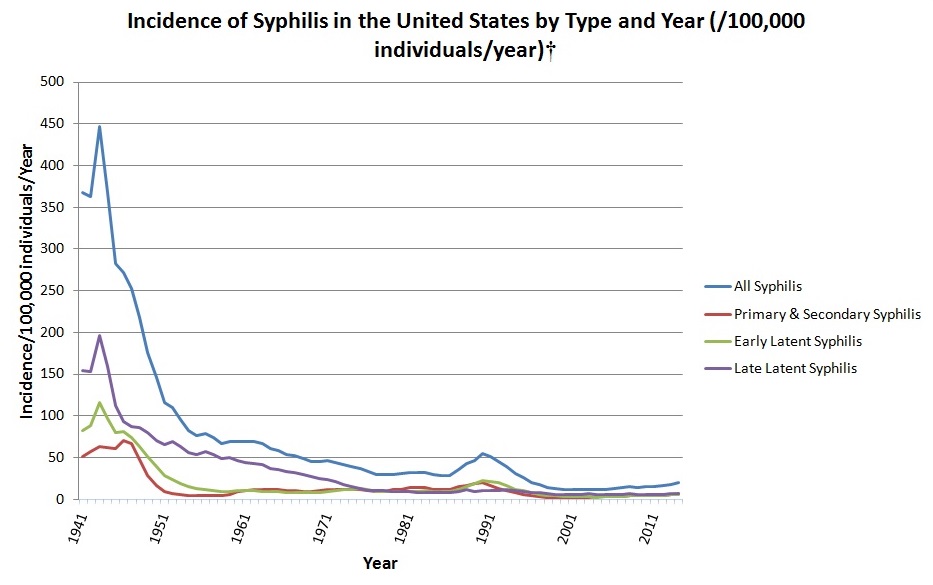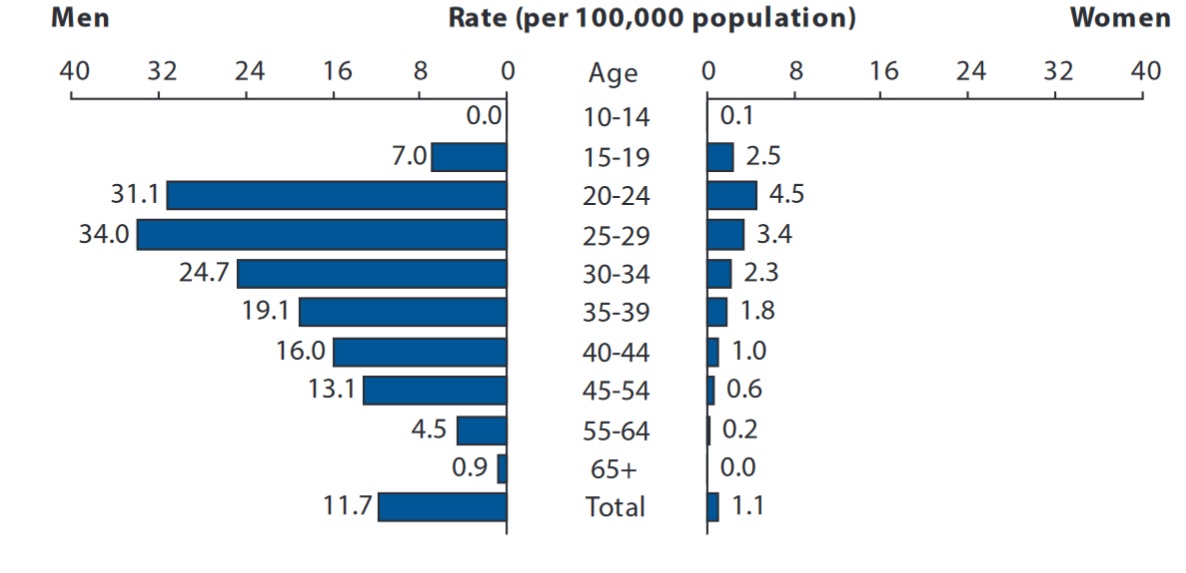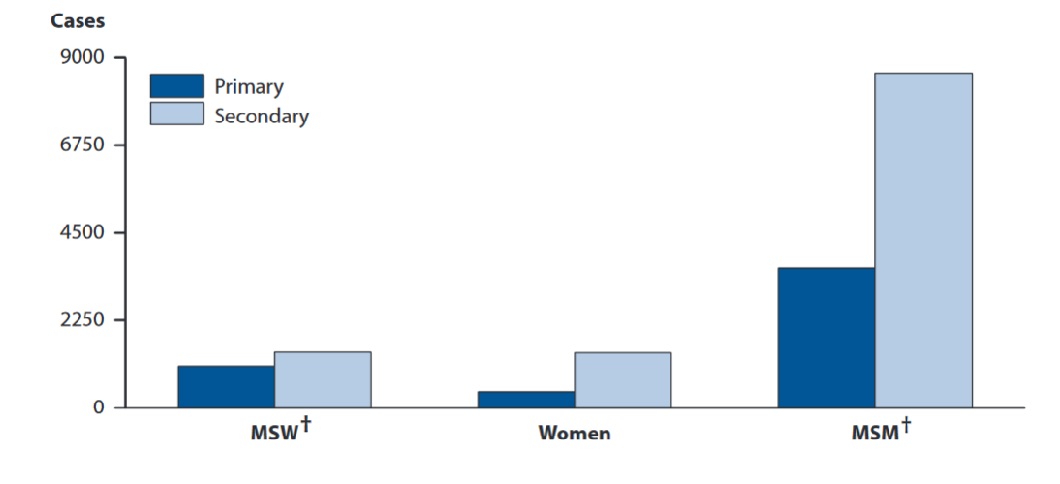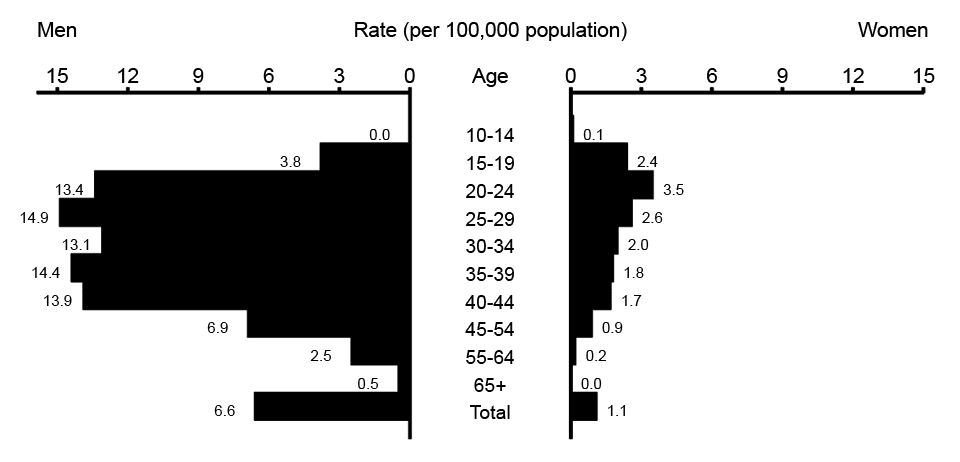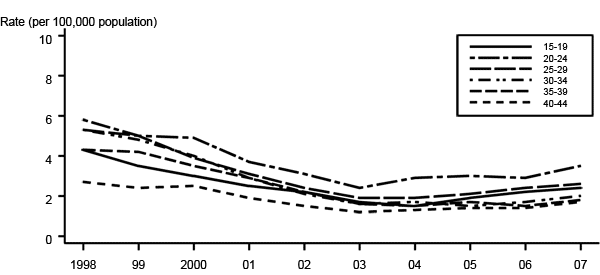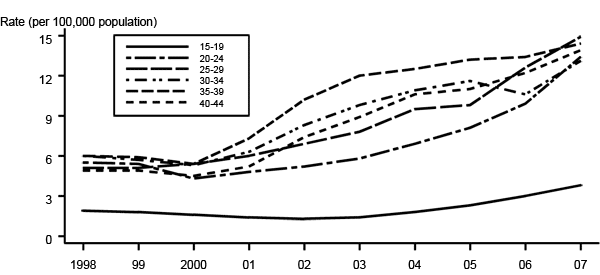Syphilis epidemiology and demographics: Difference between revisions
Aysha Aslam (talk | contribs) (→Age) |
Aysha Aslam (talk | contribs) (→Gender) |
||
| Line 33: | Line 33: | ||
*There is increased incidence of primary and secondary syphilis in men who have sex with men compared with women. However, there is no significant difference in incidence of syphilis among men who have sex with women compared with women. | *There is increased incidence of primary and secondary syphilis in men who have sex with men compared with women. However, there is no significant difference in incidence of syphilis among men who have sex with women compared with women. | ||
*In 2014, out of 19,999 total reported cases of primary and secondary syphilis, 61% were estimated to be among males who have sex with males.<ref name=CDC>https://www.cdc.gov/std/stats14/surv-2014-print.pdf Accessed on September 16, 2016</ref><ref name=WHO2012>http://apps.who.int/iris/bitstream/10665/85376/1/9789241505895_eng.pdf?=1 Accessed on September 16, 2016</ref><ref name="pmid23049658">{{cite journal| author=Purcell DW, Johnson CH, Lansky A, Prejean J, Stein R, Denning P et al.| title=Estimating the population size of men who have sex with men in the United States to obtain HIV and syphilis rates. | journal=Open AIDS J | year= 2012 | volume= 6 | issue= | pages= 98-107 | pmid=23049658 | doi=10.2174/1874613601206010098 | pmc=3462414 | url=https://www.ncbi.nlm.nih.gov/entrez/eutils/elink.fcgi?dbfrom=pubmed&tool=sumsearch.org/cite&retmode=ref&cmd=prlinks&id=23049658 }} </ref><ref name="pmid17463387">{{cite journal| author=Heffelfinger JD, Swint EB, Berman SM, Weinstock HS| title=Trends in primary and secondary syphilis among men who have sex with men in the United States. | journal=Am J Public Health | year= 2007 | volume= 97 | issue= 6 | pages= 1076-83 | pmid=17463387 | doi=10.2105/AJPH.2005.070417 | pmc=1874206 | url=https://www.ncbi.nlm.nih.gov/entrez/eutils/elink.fcgi?dbfrom=pubmed&tool=sumsearch.org/cite&retmode=ref&cmd=prlinks&id=17463387 }} </ref><ref name="pmid6893897">{{cite journal| author=Judson FN, Penley KA, Robinson ME, Smith JK| title=Comparative prevalence rates of sexually transmitted diseases in heterosexual and homosexual men. | journal=Am J Epidemiol | year= 1980 | volume= 112 | issue= 6 | pages= 836-43 | pmid=6893897 | doi= | pmc= | url=https://www.ncbi.nlm.nih.gov/entrez/eutils/elink.fcgi?dbfrom=pubmed&tool=sumsearch.org/cite&retmode=ref&cmd=prlinks&id=6893897 }} </ref> | *In 2014, out of 19,999 total reported cases of primary and secondary syphilis, 61% were estimated to be among males who have sex with males.<ref name=CDC>https://www.cdc.gov/std/stats14/surv-2014-print.pdf Accessed on September 16, 2016</ref><ref name=WHO2012>http://apps.who.int/iris/bitstream/10665/85376/1/9789241505895_eng.pdf?=1 Accessed on September 16, 2016</ref><ref name="pmid23049658">{{cite journal| author=Purcell DW, Johnson CH, Lansky A, Prejean J, Stein R, Denning P et al.| title=Estimating the population size of men who have sex with men in the United States to obtain HIV and syphilis rates. | journal=Open AIDS J | year= 2012 | volume= 6 | issue= | pages= 98-107 | pmid=23049658 | doi=10.2174/1874613601206010098 | pmc=3462414 | url=https://www.ncbi.nlm.nih.gov/entrez/eutils/elink.fcgi?dbfrom=pubmed&tool=sumsearch.org/cite&retmode=ref&cmd=prlinks&id=23049658 }} </ref><ref name="pmid17463387">{{cite journal| author=Heffelfinger JD, Swint EB, Berman SM, Weinstock HS| title=Trends in primary and secondary syphilis among men who have sex with men in the United States. | journal=Am J Public Health | year= 2007 | volume= 97 | issue= 6 | pages= 1076-83 | pmid=17463387 | doi=10.2105/AJPH.2005.070417 | pmc=1874206 | url=https://www.ncbi.nlm.nih.gov/entrez/eutils/elink.fcgi?dbfrom=pubmed&tool=sumsearch.org/cite&retmode=ref&cmd=prlinks&id=17463387 }} </ref><ref name="pmid6893897">{{cite journal| author=Judson FN, Penley KA, Robinson ME, Smith JK| title=Comparative prevalence rates of sexually transmitted diseases in heterosexual and homosexual men. | journal=Am J Epidemiol | year= 1980 | volume= 112 | issue= 6 | pages= 836-43 | pmid=6893897 | doi= | pmc= | url=https://www.ncbi.nlm.nih.gov/entrez/eutils/elink.fcgi?dbfrom=pubmed&tool=sumsearch.org/cite&retmode=ref&cmd=prlinks&id=6893897 }} </ref> | ||
====Primary and Secondary Syphilis — Reported Cases by Stage, Sex, and Sexual Behavior, 2014==== | |||
[[Image:Syphilis 3.jpg|500px]] | |||
===Race=== | ===Race=== | ||
Revision as of 16:55, 16 September 2016
Editor-In-Chief: C. Michael Gibson, M.S., M.D. [1] Associate Editor(s)-in-Chief: Aysha Anwar, M.B.B.S[2]
|
Syphilis Microchapters | |
|
Diagnosis | |
|
Treatment | |
|
Case Studies | |
|
Syphilis epidemiology and demographics On the Web | |
|
American Roentgen Ray Society Images of Syphilis epidemiology and demographics | |
|
Risk calculators and risk factors for Syphilis epidemiology and demographics | |
Overview
The rate of primary and secondary syphilis reported in the United States decreased during the 1990s; in 2000, the rate was the lowest since reporting began in 1941. The low rate of infectious syphilis and the concentration of the majority of syphilis cases in a small number of geographic areas in the United States led to the development of the CDCs National Plan to Eliminate Syphilis, which was announced by Surgeon General David Satcher in October 1999 and revised in May 2006.2
Epidemiology
Incidence
- Worldwide, the incidence of syphilis is estimated to be 12 million cases each year.[1]
- In 2008, the incidence of syphilis was estimated to be 10.9 million cases worldwide.[2][3][4]
- From year 2005 to 2014, the incidence of syphilis in USA has increased from 2.9 to 6.3 cases/100,000/year.
- The incidence of syphilis in USA in the year 2014 is described below:
- Increase in the rate of reported cases compared with 2013 is 15.1%.[5]
- Increased incidence in every region of the country with highest reported cases in the west and lowest cases in the midwest.
†Data from CDC This graph is property of wikidoc, must be redistributed.
Prevalence
- In 2008, the prevalence of syphilis was estimated to be 36.4 million cases worldwide.[2]
- In 2014, the prevalence of syphilis in USA was estimated to be 20 cases/100,000 individuals.[5]
Demographic factors
The incidence and prevalence of syphilis may be affected by the following demographic factors:[5][6]
Age
In 2014, the highest rate of primary and secondary syphilis in USA was seen in age groups 20-24 years and 25-29 years.[5]
Gender
- There is increased incidence of primary and secondary syphilis in men who have sex with men compared with women. However, there is no significant difference in incidence of syphilis among men who have sex with women compared with women.
- In 2014, out of 19,999 total reported cases of primary and secondary syphilis, 61% were estimated to be among males who have sex with males.[5][6][7][8][9]
Primary and Secondary Syphilis — Reported Cases by Stage, Sex, and Sexual Behavior, 2014
Race
- Syphilis is more prevalent in the african population as compared to other racial groups.
- In 2014, the highest incidence of primary and secondary syphilis in USA was reported to be in african american poulation and lowest incidence was observed in whites, asians and mutiracial groups.[5]
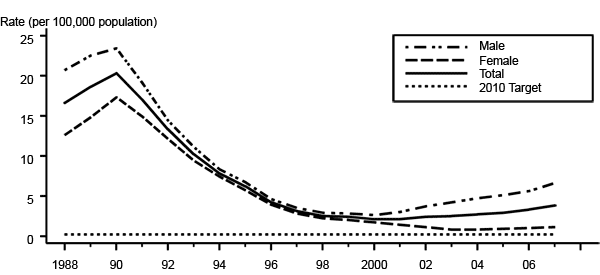

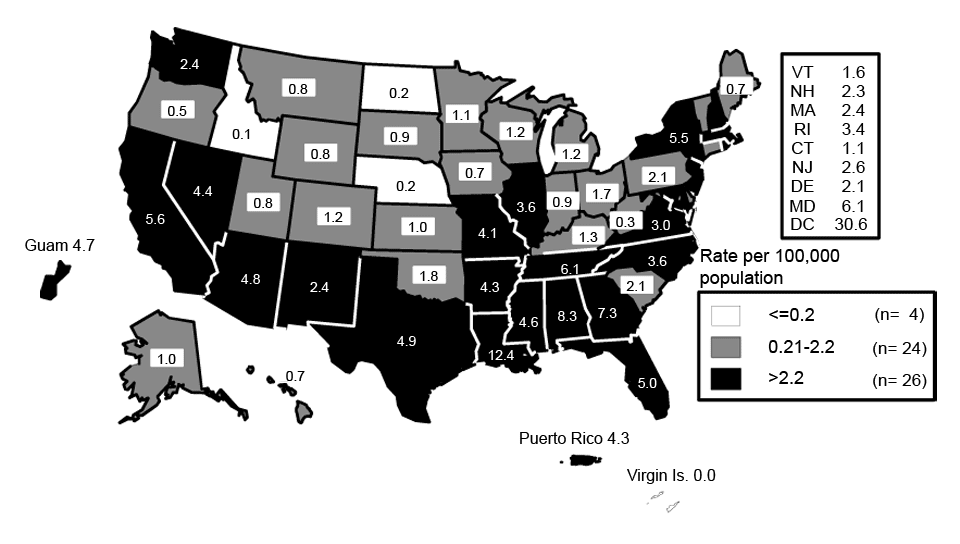
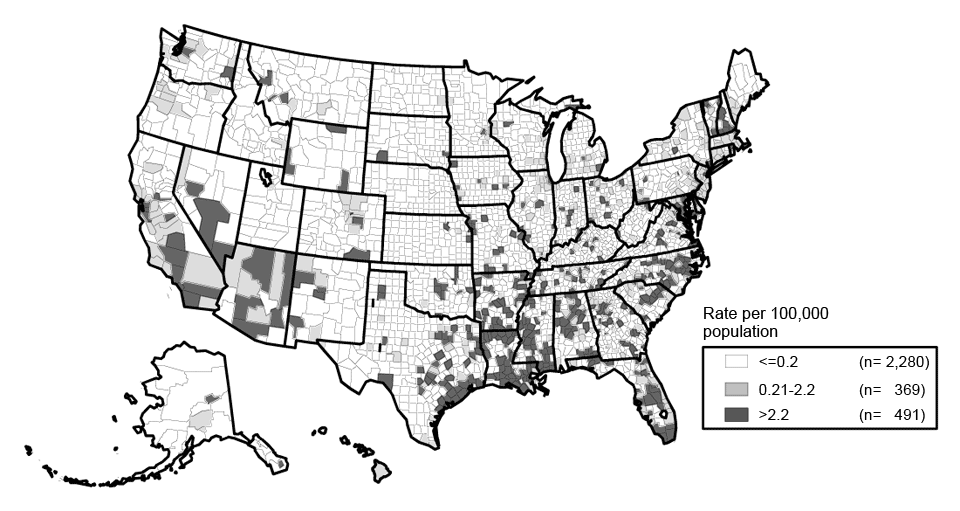
References
- ↑ Hook EW, Peeling RW (2004). "Syphilis control--a continuing challenge". N Engl J Med. 351 (2): 122–4. doi:10.1056/NEJMp048126. PMID 15247352.
- ↑ 2.0 2.1 http://apps.who.int/iris/bitstream/10665/75181/1/9789241503839_eng.pdf Accessed on September 16, 2016
- ↑ Herbert LJ, Middleton SI (2012). "An estimate of syphilis incidence in Eastern Europe". J Glob Health. 2 (1): 010402. doi:10.7189/jogh.02.010402. PMC 3484754. PMID 23198131.
- ↑ Kenyon CR, Osbak K, Tsoumanis A (2016). "The Global Epidemiology of Syphilis in the Past Century - A Systematic Review Based on Antenatal Syphilis Prevalence". PLoS Negl Trop Dis. 10 (5): e0004711. doi:10.1371/journal.pntd.0004711. PMC 4864207. PMID 27167068.
- ↑ 5.0 5.1 5.2 5.3 5.4 5.5 https://www.cdc.gov/std/stats14/surv-2014-print.pdf Accessed on September 16, 2016
- ↑ 6.0 6.1 http://apps.who.int/iris/bitstream/10665/85376/1/9789241505895_eng.pdf?ua=1 Accessed on September 16, 2016
- ↑ Purcell DW, Johnson CH, Lansky A, Prejean J, Stein R, Denning P; et al. (2012). "Estimating the population size of men who have sex with men in the United States to obtain HIV and syphilis rates". Open AIDS J. 6: 98–107. doi:10.2174/1874613601206010098. PMC 3462414. PMID 23049658.
- ↑ Heffelfinger JD, Swint EB, Berman SM, Weinstock HS (2007). "Trends in primary and secondary syphilis among men who have sex with men in the United States". Am J Public Health. 97 (6): 1076–83. doi:10.2105/AJPH.2005.070417. PMC 1874206. PMID 17463387.
- ↑ Judson FN, Penley KA, Robinson ME, Smith JK (1980). "Comparative prevalence rates of sexually transmitted diseases in heterosexual and homosexual men". Am J Epidemiol. 112 (6): 836–43. PMID 6893897.
